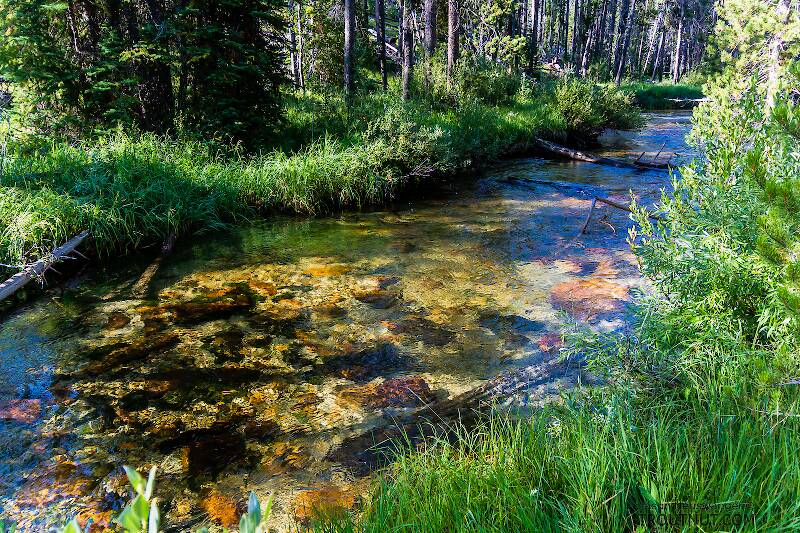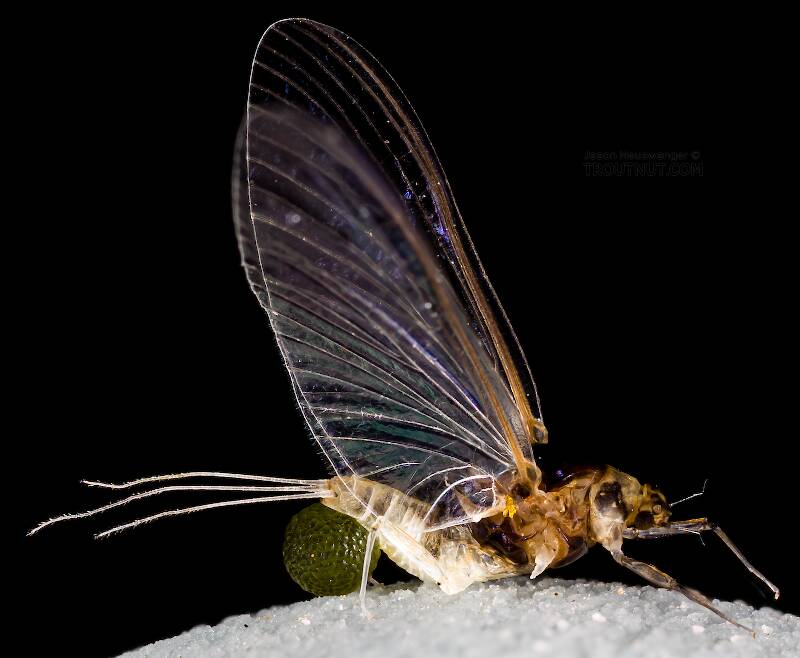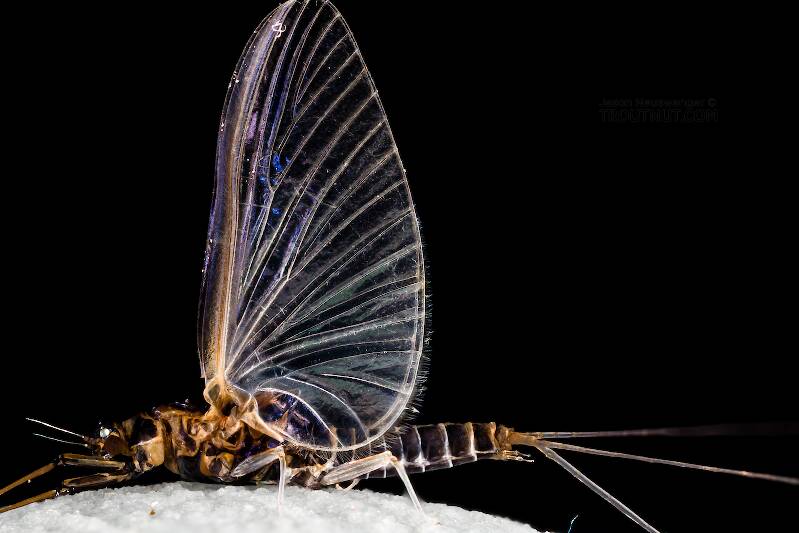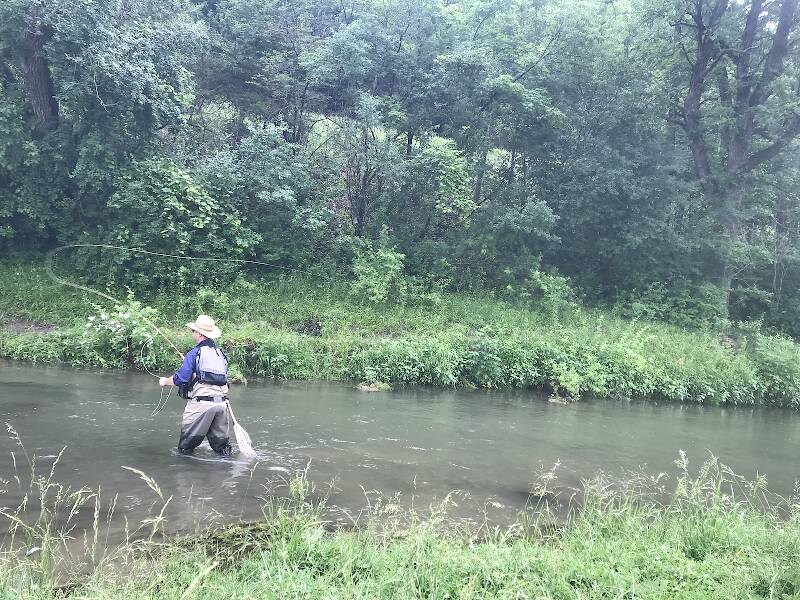
Hex Mayflies
Hexagenia limbata
The famous nocturnal Hex hatch of the Midwest (and a few other lucky locations) stirs to the surface mythically large brown trout that only touch streamers for the rest of the year.
Featured on the forum

I was not fishing, but happened to be at an unrelated social event on a hill above this tiny creek (which I never even saw) when this stonefly flew by me. I assume it came from there. Some key characteristics are tricky to follow, but process of elimination ultimately led me to Sweltsa borealis. It is reassuringly similar to this specimen posted by Bob Newell years ago. It is also so strikingly similar to this nymph from the same river system that I'm comfortable identifying that nymph from this adult. I was especially pleased with the closeup photo of four mites parasitizing this one.

Troutnut is a project started in 2003 by salmonid ecologist Jason "Troutnut" Neuswanger to help anglers and
fly tyers unabashedly embrace the entomological side of the sport. Learn more about Troutnut or
support the project for an enhanced experience here.
This topic is about the Mayfly Genus Tricorythodes
A cult following is something to which few insects can lay claim, but the tiny Tricorythodes mayflies certainly qualify. Their widespread, reliable, heavy hatches draw impressive rises of ultra-selective trout which demand the most of a technical dry-fly angler's skills.It is surprising that such a great hatch took so long to come to the attention of fly fishermen. The Tricos were first introduced to anglers in a 1969 Outdoor Life article by Vincent Marinaro, who misidentified them as Caenis. By the early 1970s the identification had been corrected but Swisher and Richards still wrote in Selective Trout, "Few anglers are familiar with these extremely small but important mayflies." The next wave of publications boosted Tricorythodes to its current fame. I suspect their early dismissal was due in part to tackle limitations; anglers in the 1950s had no means to effectively tie and present size 22-28 flies.
Example specimens
Bwoklink on Jul 14, 2018July 14th, 2018, 2:10 am EDT
Anyone have experience fishing Trico emergers patterns? I've had experience fishing the winged and spinner stage, but haven't heard of anyone fishing emergers during the early morning female hatch. Anyone used emerger patterns and if so would you might sharing which ones you have found effective?
Wbranch on Jul 14, 2018July 14th, 2018, 3:51 am EDT
Trico emergers, in my opinion, are a waste of time. Put on a dun and fish it as long as you see those little dun upright wings and green abdomens floating by and then switch over to a #20 Adams parachute with a white post.
Catskill fly fisher for fifty-five years.
Afishinado on Jul 15, 2018July 15th, 2018, 12:31 am EDT
I've had a great amount to success fishing the Al's Trico pattern during the spinner fall. Below is a summary and the link has a video showing the finished fly and how it's tied. I use black thread for males and white thread or light olive thread for the abdomen to imitate the female spinners.
Al's Trico by Al Miller of Pennsylvania is one of the most effective Trico patterns ever. It also happens to be relatively easy to tie, even in the smallest of sizes. When trout get fussy during a trico hatch, it's often a matter of size, and smaller flies usually win out.
Here I'm going to tie an Al's Trico on a size 24 TMC 100 dry fly hook. As you can see here, the size 24 is dwarfed by a size 12. Take note of how much thicker the wire is on the 12. Although I usually use the vise jaws to mash the barbs on hooks, I like to use very fine needle-nosed pliers for hooks this small. If you have midge jaws for your vise, by all means use them.
For thread, I'm going to use black UTC 70 Denier. Load it on a small midge bobbin if you have one. Start your thread at the halfway point on the hook shank and take wraps rearward to about the hook point and then snip the tag end off close. Wrapping back to the bend, cover up the tag and wind your thread forward to just behind the hook point.
Although this is a size 24, you want to use slightly oversized hackle, here, size 20 from a Whiting 100's pack. Although the original pattern called for grizzly hackle, and I'm going to use it here, I really like the look of light dun a little better. It's up to you.
With the shiny side of the hackle facing towards you, pull down about 1/8th of an inch of fibers at the butt end. With your tying scissors, snip these fibers off close to the stem then strip another 1/8th of an inch of fibers from the top to ensure it wraps correctly. Tie in the hackle stem with a few tight wraps of thread.
To beef up the thorax of the fly a little bit, I like to use just the smallest amount of black dry fly dubbing, here, Wapsi Super Fine. Go very light, just a few fibers are all that's needed.
The dubbing noodle should be short and just barely cover your tying thread. Wrap the dubbing around the hook shank to form a bulbous little thorax. With that done, begin wrapping your hackle, 3 or 4 turns are all you need. Secure the hackle with 2 or 3 turns of tying thread and then pull the remainder of the hackle and the hackle fibers rearward and take a couple more wraps of tying thread. You can then snip the remainder of the hackle off close.
Do a 5 or 6 turn whip finish to secure the tying thread and elongate the body of the fly. You can then cut or snip your tying thread free.
The pattern fishes fine just like this, but many anglers prefer to trim the bottom hackle fibers off so the fly rests in the film. I usually carry both. Once again, I like this pattern with dun colored hackle like those to the right and at the top but there's certainly nothing wrong with grizzly hackle either. I've heard some anglers will leave the tag end of their tippet untrimmed to give the impression of a long split tail like on the naturals. This is 7X which should give you an idea of just how small this fly really is. It's a great pattern, give it a try.
Link to Source: https://howtoflyfish.orvis.com/fly-tying-videos/dry-flies/741-als-trico?adv=87072&cm_mmc=Orvisnonbrand-_-Nontm-m-shoes-us-dsarlsa-_-Nontm-x-shoes-x-x-x-x-_-&gclid=CjwKCAjw4avaBRBPEiwA_ZetYhaDmLnn14PD-a7TXhIkunxGkauqinYR7L4QJBhi8GubwlwhYHL1khoCYVIQAvD_BwE
I recall bringing the pattern out the WestBranches River(the MO) back in the early and mid 90's, when it was really lonely out there. I caught and lost more big fish than one can imagine during the spinnerfall. My best days ever fishing size 24 flies. Good stuff.
Al's Trico by Al Miller of Pennsylvania is one of the most effective Trico patterns ever. It also happens to be relatively easy to tie, even in the smallest of sizes. When trout get fussy during a trico hatch, it's often a matter of size, and smaller flies usually win out.
Here I'm going to tie an Al's Trico on a size 24 TMC 100 dry fly hook. As you can see here, the size 24 is dwarfed by a size 12. Take note of how much thicker the wire is on the 12. Although I usually use the vise jaws to mash the barbs on hooks, I like to use very fine needle-nosed pliers for hooks this small. If you have midge jaws for your vise, by all means use them.
For thread, I'm going to use black UTC 70 Denier. Load it on a small midge bobbin if you have one. Start your thread at the halfway point on the hook shank and take wraps rearward to about the hook point and then snip the tag end off close. Wrapping back to the bend, cover up the tag and wind your thread forward to just behind the hook point.
Although this is a size 24, you want to use slightly oversized hackle, here, size 20 from a Whiting 100's pack. Although the original pattern called for grizzly hackle, and I'm going to use it here, I really like the look of light dun a little better. It's up to you.
With the shiny side of the hackle facing towards you, pull down about 1/8th of an inch of fibers at the butt end. With your tying scissors, snip these fibers off close to the stem then strip another 1/8th of an inch of fibers from the top to ensure it wraps correctly. Tie in the hackle stem with a few tight wraps of thread.
To beef up the thorax of the fly a little bit, I like to use just the smallest amount of black dry fly dubbing, here, Wapsi Super Fine. Go very light, just a few fibers are all that's needed.
The dubbing noodle should be short and just barely cover your tying thread. Wrap the dubbing around the hook shank to form a bulbous little thorax. With that done, begin wrapping your hackle, 3 or 4 turns are all you need. Secure the hackle with 2 or 3 turns of tying thread and then pull the remainder of the hackle and the hackle fibers rearward and take a couple more wraps of tying thread. You can then snip the remainder of the hackle off close.
Do a 5 or 6 turn whip finish to secure the tying thread and elongate the body of the fly. You can then cut or snip your tying thread free.
The pattern fishes fine just like this, but many anglers prefer to trim the bottom hackle fibers off so the fly rests in the film. I usually carry both. Once again, I like this pattern with dun colored hackle like those to the right and at the top but there's certainly nothing wrong with grizzly hackle either. I've heard some anglers will leave the tag end of their tippet untrimmed to give the impression of a long split tail like on the naturals. This is 7X which should give you an idea of just how small this fly really is. It's a great pattern, give it a try.
Link to Source: https://howtoflyfish.orvis.com/fly-tying-videos/dry-flies/741-als-trico?adv=87072&cm_mmc=Orvisnonbrand-_-Nontm-m-shoes-us-dsarlsa-_-Nontm-x-shoes-x-x-x-x-_-&gclid=CjwKCAjw4avaBRBPEiwA_ZetYhaDmLnn14PD-a7TXhIkunxGkauqinYR7L4QJBhi8GubwlwhYHL1khoCYVIQAvD_BwE
I recall bringing the pattern out the WestBranches River(the MO) back in the early and mid 90's, when it was really lonely out there. I caught and lost more big fish than one can imagine during the spinnerfall. My best days ever fishing size 24 flies. Good stuff.
Martinlf on Jul 20, 2018July 20th, 2018, 7:21 am EDT
So, from the other thread, it appears it was years ago that Matt shared his dun pattern with me. It's now my favorite, and the only one I have solid confidence in. I did create an emerger pattern some years back, and have caught a few fish on it, but I'll tie on Matt's pattern first. I looked to see if I'd saved any notes on my emerger, and haven't. Here's the idea: use a Daiichi 1130 hook or similar scud hook in the proper size. Use 14/0 Veevus brown thread. Use dark brown very fine dubbing. Tie in a tail of some brown wet fly fibers and dub a very thin abdomen. Tie in a longish black spinner wing of poly yarn where the abdomen ends. Dub a thorax in front of the spinner wing leaving 2 hook eye lengths bard just behind the hook eye. Tie in a short wing of fine snowshoe fur just in front of the thorax, then pull the spinner wing tips forward to create a wingcase around the wing, tieing off the poly yarn at the eye. Whip finish and clip the extra poly yarn. I'm not sure that the wing case does anything but cause the tier extra trouble, but I do it anyway. I've used this pattern on other small mayflies a few times too.
Below is my parachute spinner, modeled on Al's trico. It's a bit more visible and has taken some picky fish. Colored post versions are very helpful in glare. The fish don't seem to mind them at all.
My standard Trico is based on Al's Trico. It lets me get an Al's Trico silhouette with a much more visible parachute fly. For all my Tricos I use a short shank hook, (Tiemco 500U, Tiemco 2488, Tiemco 921, Daichi 1640, or best of all. if you can find them, a Varivas 2300). I begin by winding two or three layers of 10/0 thread on the shank for the abdomen (black for males, white, green, or chartreuse for females. With females, I whip finish the thread, then tie in black just at the bend and finish with black thread), I tie in a white high vis post near the bend. Other materials may be used, and black, pink or orange posts can sometimes better be seen in glare. I use Gary Borger's method, slipping the high vis under the shank and pulling both ends up to create a post that can't pull out. A few X wraps under the hook to secure the post, a tiny drop of super glue at the base and some more quick X wraps and posting wraps at the base of the post and up a bit, and the post is ready and won't slip around later. Then I strip some barbs from an oversize grizzly hackle, tie in it in along the shank and then wrap the stem up the post to to reinforce and stiffen the post. Next I wrap a small ball of black dubbing for the thorax, wrap the hackle around the post and tie off. (I wrap clockwise and when done, trap the hackle stem with the thread under the wraps, and with the hackle tip pulled straight down by the hackle pliers, whip finish using a whip finish tool under the hackle on the post with a few wraps--usually 3. A ultra-mini drop of gorilla glue on the thread of the final whip finish loop that is going to be pulled into the knot is pulled in from below, avoiding the hackle, to lock it all in permanently.)
Or you can wrap the parachute counter-clockwise and tie off on the shank, just behind the thorax, whip finishing along the shank.) Finally, if you wish (though I’ve stopped doing this for tiny flies), snip off some hackle barbs just above the eye and the shank to create the illusion of two wings to the sides, and your’re done. That’s right. No tails. The high vis post makes the fly much easier to see than Al's Trico, and it can be left long or trimmed/flattened if the fish seem to mind it. I haven't noticed that they do mind the post, though some fish seem to want a different style of fly sometimes. Hard fished Spring Creek trout in State College took the parachute readily when I tried it on them. It's often the first pattern I tie on, switching around to other styles if the fish won't take it. The parachute Trico can be used as a midge imitation also. I use this pattern, reverse style as above, or with the parachute near the eye for larger spinners as well, though I do add tails for these usually.
Below is my parachute spinner, modeled on Al's trico. It's a bit more visible and has taken some picky fish. Colored post versions are very helpful in glare. The fish don't seem to mind them at all.
My standard Trico is based on Al's Trico. It lets me get an Al's Trico silhouette with a much more visible parachute fly. For all my Tricos I use a short shank hook, (Tiemco 500U, Tiemco 2488, Tiemco 921, Daichi 1640, or best of all. if you can find them, a Varivas 2300). I begin by winding two or three layers of 10/0 thread on the shank for the abdomen (black for males, white, green, or chartreuse for females. With females, I whip finish the thread, then tie in black just at the bend and finish with black thread), I tie in a white high vis post near the bend. Other materials may be used, and black, pink or orange posts can sometimes better be seen in glare. I use Gary Borger's method, slipping the high vis under the shank and pulling both ends up to create a post that can't pull out. A few X wraps under the hook to secure the post, a tiny drop of super glue at the base and some more quick X wraps and posting wraps at the base of the post and up a bit, and the post is ready and won't slip around later. Then I strip some barbs from an oversize grizzly hackle, tie in it in along the shank and then wrap the stem up the post to to reinforce and stiffen the post. Next I wrap a small ball of black dubbing for the thorax, wrap the hackle around the post and tie off. (I wrap clockwise and when done, trap the hackle stem with the thread under the wraps, and with the hackle tip pulled straight down by the hackle pliers, whip finish using a whip finish tool under the hackle on the post with a few wraps--usually 3. A ultra-mini drop of gorilla glue on the thread of the final whip finish loop that is going to be pulled into the knot is pulled in from below, avoiding the hackle, to lock it all in permanently.)
Or you can wrap the parachute counter-clockwise and tie off on the shank, just behind the thorax, whip finishing along the shank.) Finally, if you wish (though I’ve stopped doing this for tiny flies), snip off some hackle barbs just above the eye and the shank to create the illusion of two wings to the sides, and your’re done. That’s right. No tails. The high vis post makes the fly much easier to see than Al's Trico, and it can be left long or trimmed/flattened if the fish seem to mind it. I haven't noticed that they do mind the post, though some fish seem to want a different style of fly sometimes. Hard fished Spring Creek trout in State College took the parachute readily when I tried it on them. It's often the first pattern I tie on, switching around to other styles if the fish won't take it. The parachute Trico can be used as a midge imitation also. I use this pattern, reverse style as above, or with the parachute near the eye for larger spinners as well, though I do add tails for these usually.
"He spread them a yard and a half. 'And every one that got away is this big.'"
--Fred Chappell
--Fred Chappell
Martinlf on Jul 31, 2020July 31st, 2020, 6:13 am EDT
Mike, see if any of this helps. We have some photos of trico patterns somewhere on Troutnut, but I can't locate the thread.
"He spread them a yard and a half. 'And every one that got away is this big.'"
--Fred Chappell
--Fred Chappell
JohnMD1022 on Sep 10, 2020September 10th, 2020, 7:58 am EDT
I tied my first trico emergers in 1974 for use on the upper Yellow Breeches where the spinner fall was not overwhelming.
I hooked/lost/landed several good fish there, including an 18" Brookie.
While it was quite successful on that stretch of the Yellow Breeches, it's usefulness varied on other streams.
On Falling Springs, for example, it was just another pattern. It worked, but no better than other flies.
The pattern is simple and the hook can be a bit larger than usual, e.g., 18 or 20 dry fly hooks.
Thread: Pre-waxed olive
Tail: 2-4 hackle barbs, tied split fashion, pale dun.
Body: Pale cream Seal's Fur
Thorax: Brown Seal's Fur
That's it.
The last I knew Seal's Fur was available from Great Feathers.
https://www.greatfeathers.com
john
I hooked/lost/landed several good fish there, including an 18" Brookie.
While it was quite successful on that stretch of the Yellow Breeches, it's usefulness varied on other streams.
On Falling Springs, for example, it was just another pattern. It worked, but no better than other flies.
The pattern is simple and the hook can be a bit larger than usual, e.g., 18 or 20 dry fly hooks.
Thread: Pre-waxed olive
Tail: 2-4 hackle barbs, tied split fashion, pale dun.
Body: Pale cream Seal's Fur
Thorax: Brown Seal's Fur
That's it.
The last I knew Seal's Fur was available from Great Feathers.
https://www.greatfeathers.com
john
Martinlf on Sep 11, 2020September 11th, 2020, 7:36 am EDT
Thanks for the pattern; I hope you're still fishing tricos. An 18" fish on a trico can keep you occupied, that's for sure. Recently on my parachute spinner I've been using a two or three wrap whip finish under the hackle, around the post, not cutting the thread, but rather winding the thread back along the shank to the eye and whip finishing there. It creates less bulk under the hackle and lets it sit closer to the body. Not that it matters all that much--just something I've started doing to please myself.
"He spread them a yard and a half. 'And every one that got away is this big.'"
--Fred Chappell
--Fred Chappell
Quick Reply
Related Discussions
Topic
Replies
Last Reply
3
Jan 16, 2007
by Martinlf
by Martinlf
4
Sep 29, 2016
by Wiflyfisher
by Wiflyfisher
Re: Three Trouble Makers at the Midwest Fly Fishing Expo the past weekend

In the Photography Board by Oldredbarn

In the Photography Board by Oldredbarn
3
Mar 11, 2014
by TNEAL
by TNEAL







